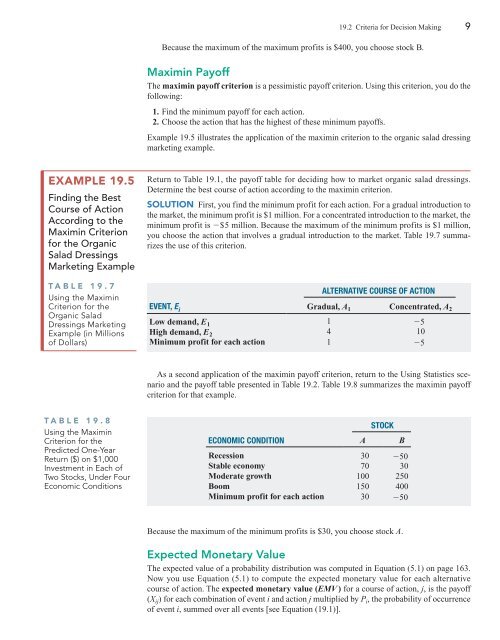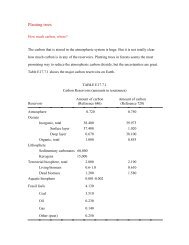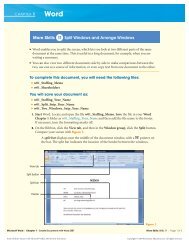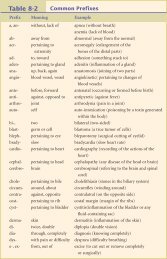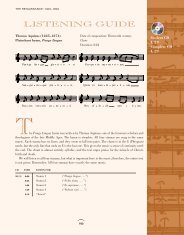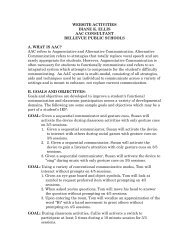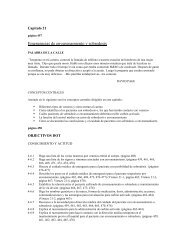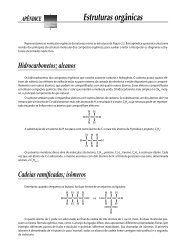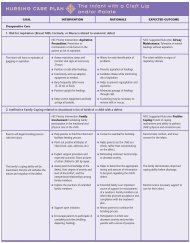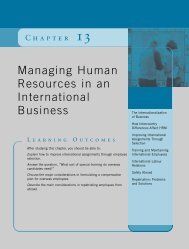19.1 Payoff Tables and Decision Trees
19.1 Payoff Tables and Decision Trees
19.1 Payoff Tables and Decision Trees
You also want an ePaper? Increase the reach of your titles
YUMPU automatically turns print PDFs into web optimized ePapers that Google loves.
EXAMPLE 19.5<br />
Finding the Best<br />
Course of Action<br />
According to the<br />
Maximin Criterion<br />
for the Organic<br />
Salad Dressings<br />
Marketing Example<br />
TABLE 19.7<br />
Using the Maximin<br />
Criterion for the<br />
Organic Salad<br />
Dressings Marketing<br />
Example (in Millions<br />
of Dollars)<br />
TABLE 19.8<br />
Using the Maximin<br />
Criterion for the<br />
Predicted One-Year<br />
Return ($) on $1,000<br />
Investment in Each of<br />
Two Stocks, Under Four<br />
Economic Conditions<br />
19.2 Criteria for <strong>Decision</strong> Making 9<br />
Because the maximum of the maximum profits is $400, you choose stock B.<br />
Maximin <strong>Payoff</strong><br />
The maximin payoff criterion is a pessimistic payoff criterion. Using this criterion, you do the<br />
following:<br />
1. Find the minimum payoff for each action.<br />
2. Choose the action that has the highest of these minimum payoffs.<br />
Example 19.5 illustrates the application of the maximin criterion to the organic salad dressing<br />
marketing example.<br />
Return to Table <strong>19.1</strong>, the payoff table for deciding how to market organic salad dressings.<br />
Determine the best course of action according to the maximin criterion.<br />
SOLUTION First, you find the minimum profit for each action. For a gradual introduction to<br />
the market, the minimum profit is $1 million. For a concentrated introduction to the market, the<br />
minimum profit is - $5 million. Because the maximum of the minimum profits is $1 million,<br />
you choose the action that involves a gradual introduction to the market. Table 19.7 summarizes<br />
the use of this criterion.<br />
ALTERNATIVE COURSE OF ACTION<br />
EVENT, Ei Gradual, A1 Concentrated, A2 Low dem<strong>and</strong>, E1 1 -5<br />
High dem<strong>and</strong>, E2 4 10<br />
Minimum profit for each action 1 -5<br />
As a second application of the maximin payoff criterion, return to the Using Statistics scenario<br />
<strong>and</strong> the payoff table presented in Table 19.2. Table 19.8 summarizes the maximin payoff<br />
criterion for that example.<br />
STOCK<br />
ECONOMIC CONDITION A B<br />
Recession 30 -50<br />
Stable economy 70 30<br />
Moderate growth 100 250<br />
Boom 150 400<br />
Minimum profit for each action 30 -50<br />
Because the maximum of the minimum profits is $30, you choose stock A.<br />
Expected Monetary Value<br />
The expected value of a probability distribution was computed in Equation (5.1) on page 163.<br />
Now you use Equation (5.1) to compute the expected monetary value for each alternative<br />
course of action. The expected monetary value (EMV ) for a course of action, j, is the payoff<br />
(Xij) for each combination of event i <strong>and</strong> action j multiplied by Pi, the probability of occurrence<br />
of event i, summed over all events [see Equation (<strong>19.1</strong>)].


